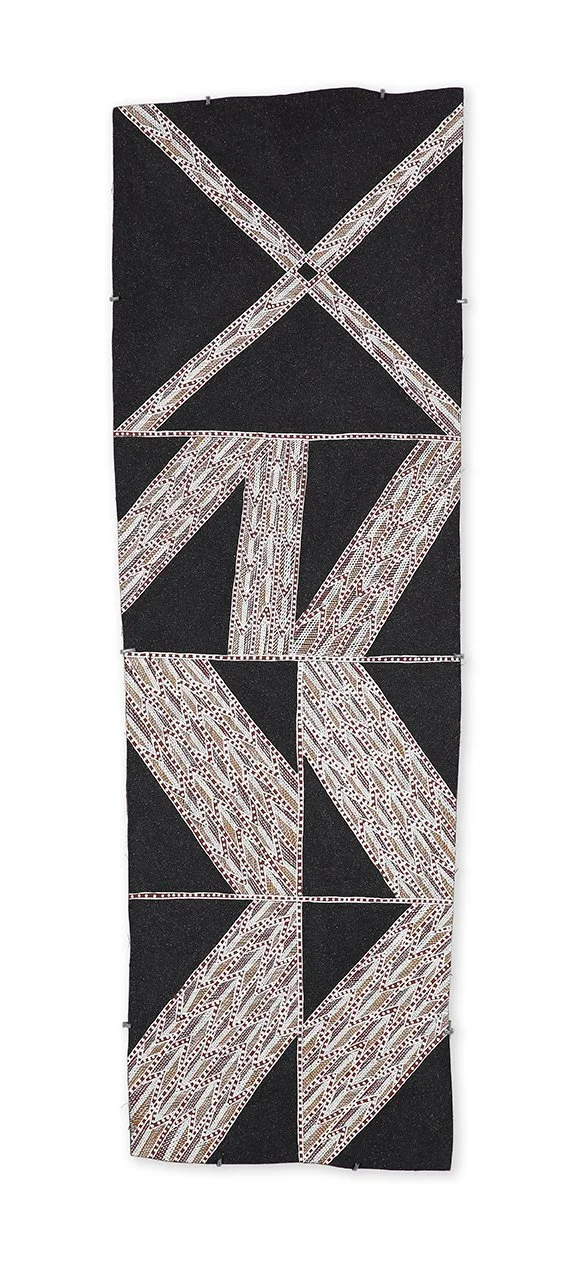Milŋ’milŋdhun - Shimmer
2022
IN ASSOCIATION WITH
BUKU-LARRŊGAY MULKA CENTRE
AND TACTILE ARTS
19 Conacher Street The Gardens
Phone +61 8 8981 6616
OPENING HOURS
TUE to SUN
10 am – 4 pm
“When people look at my paintings I want them to see the water moving around. ”
I first met Wathaltja when she was young child, nearly 50 years ago. She comes from a family of renowned artists of the Marrakulu clan of the Dhuwa moiety, and developed her skills as an apprentice to her older sisters Boliny and Ralwurrandji. I recently talked to her about her own work. She told me that she began to paint in her own right after her sisters passed away, having been given permission to paint her miny’tji (clan designs) by her brother Yalanba, also an artist. Her body of work is a deep reflection on the gapu (waters) named Guḏultja offshore from Gurka’wuy on Trial Bay. Guḏultja is also found in other Marrakulu places – off Bayapula on Caledon Bay and Manbalala on Myaoola Bay. While her paintings are comprised of elements of her clan miny’tji, she stresses that the form they take comes from her own mind as she adapts the miny’tji to the surface she is painting on: ‘These paintings come from my mind. I thought after my sisters died I would find another way of showing the gapu’.
In her fashioning of the Marrakulu miny’tji for Guḏultja the dots represent the bubbles in the water and the lines are the cross currents and the changing direction of the flows. Wathaltja tells me that the shape of the lines reflects the shapes of the water as it moves around and between the rocks at Gurka’wuy and Bayapula. And as she talks she moves her hands up and down, reflecting the shapes of the waves and the movement of the currents as the seasons change and the tides flow: ‘I want people to see the pattern of the water as you are looking at the sea’. Where there are circles in the paintings they show the rocks and islets off shore, the rock called Bamuruŋu, also called Bulunmirri, many names. There are many more names for rocks in the Guḏultja waters: Bulunmirri, Nyulanyula and Dharrŋinydja, Balumba, Dundiwuy, Banduray, Mandikayitjpi, Walarrwalarr. Some of these are also names of people – Marrakulu people and their gurrutu (family members) from other Dhuwa moiety clans – passed down through the generations, connecting people to place.
Wathaltja says: ‘When people look at my paintings I want them to see the water moving around. That gapu sometimes it goes up and down; when the wind comes the surface is rough, and when it is calm the surface is smooth. Sometimes where the fresh water from the land mixes with the salt water the colours mix, black and white together.’ In addition to ochres she uses the black sand called Raŋimurra, Ganditji and Walanba which is found on the beaches in Marrakulu country at Gurka’wuy and at Bayapula: ‘When you move your foot through the sand and lift it up, the sand sparkles and shines back at you. The shining is milŋ’milŋdhun, you can see the light shining into your eye.’
Through these paintings Wathaltja is expressing deep emotions that connect her to her brothers and sisters, and to places in her sea country.
-HOWARD MORPHY, 2022
IMAGE: Wathaltja (Dhambit) Wanambi working on artwork, Guḏultja, 2020, 152 x 65 cm, earth pigment and sand on bark
PHOTO BY DAVID WICKENS – BUKU-LARRŊGAY MULKA CENTRE
Selected works




























